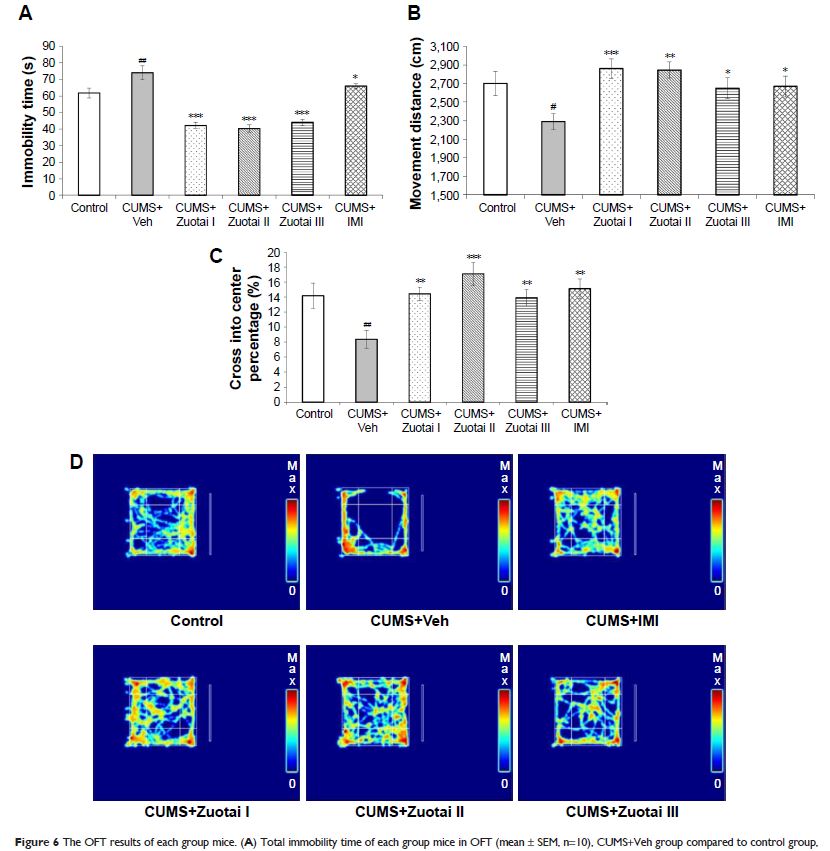108985
论文已发表
注册即可获取德孚的最新动态
IF 收录期刊
- 3.4 Breast Cancer (Dove Med Press)
- 3.2 Clin Epidemiol
- 2.6 Cancer Manag Res
- 2.9 Infect Drug Resist
- 3.7 Clin Interv Aging
- 5.1 Drug Des Dev Ther
- 3.1 Int J Chronic Obstr
- 6.6 Int J Nanomed
- 2.6 Int J Women's Health
- 2.9 Neuropsych Dis Treat
- 2.8 OncoTargets Ther
- 2.0 Patient Prefer Adher
- 2.2 Ther Clin Risk Manag
- 2.5 J Pain Res
- 3.0 Diabet Metab Synd Ob
- 3.2 Psychol Res Behav Ma
- 3.4 Nat Sci Sleep
- 1.8 Pharmgenomics Pers Med
- 2.0 Risk Manag Healthc Policy
- 4.1 J Inflamm Res
- 2.0 Int J Gen Med
- 3.4 J Hepatocell Carcinoma
- 3.0 J Asthma Allergy
- 2.2 Clin Cosmet Investig Dermatol
- 2.4 J Multidiscip Healthc

藏药佐太对不可预见慢性轻度应激小鼠抑郁样行为的改善作用: 下丘脑 - 垂体 - 肾上腺轴(HPA)轴通路
Authors Zhao J, Niu C, Wang J, Yang H, Du Y, Wei L, Li C
Received 7 September 2017
Accepted for publication 13 October 2017
Published 3 January 2018 Volume 2018:14 Pages 129—141
DOI https://doi.org/10.2147/NDT.S151107
Checked for plagiarism Yes
Review by Single-blind
Peer reviewers approved by Prof. Dr. Roumen Kirov
Peer reviewer comments 2
Editor who approved publication: Professor Wai Kwong Tang
Background: Zuotai, a famous Tibetan medicinal mixture containing
metacinnabar, is traditionally used for the purpose of tranquilizing minds and
soothing nerves. However, it still lacks substantial experimental data for it
to be approved for use.
Aim: This study was designed to assess the effects of
Zuotai on depressive-like symptoms in a chronic unpredictable mild stress
(CUMS) mouse model, and to explore its potential mechanism, particularly the
hypothalamic–pituitary–adrenal (HPA) axis pathway.
Materials and methods: First, Kunming mice were exposed to the CUMS
procedure and simultaneously administered Zuotai or imipramine (positive
control) by gavage continuously for 6 weeks. Then, depressive-like behaviors of
mice in each group were tested with the sucrose preference test, forced
swimming test, tail suspension test, and open field test. Meanwhile, the three
key neuroendocrine hormones (corticotropin releasing hormone, adrenocorticotropic
hormone and corticosterone) in HPA axis pathway, and the level of the
emotion-related monoamine neurotransmitters (5-hydroxytryptamine and
norepinephrine) were measured using enzyme-linked immunosorbent assay.
Furthermore, total mercury in the hypothalamus and hippocampus were determined
using an automatic, direct mercury analyzer.
Results: Zuotai or imipramine significantly increased the
body weight and the sucrose preference ratio in sucrose preference test, and
dramatically improved motor activity in forced swimming test, tail suspension
test, and open field test in CUMS mice. Zuotai or imipramine remarkably
decreased levels of corticotropin-releasing hormone, adrenocorticotropic
hormone, and corticosterone in the HPA axis, and increased levels of 5-hydroxytryptamine
and norepinephrine in the serum in CUMS mice. However, a small amount of
mercury was deposited in the hypothalamus and hippocampus in Zuotai-treated
mice, which may pose a potential risk to the central nervous system.
Conclusion: Zuotai has a strong ability to ameliorate
depressive-like behaviors in CUMS-treated mice through inhibition of the HPA
axis and upregulation of monoamine neurotransmitters. These findings provide
new insight into the pharmacological effect of Zuotai on depression.
Keywords: Tibetan
medicine, Zuotai, HgS, depression, chronic unpredictable mild stress, CUMS, HPA
axis
